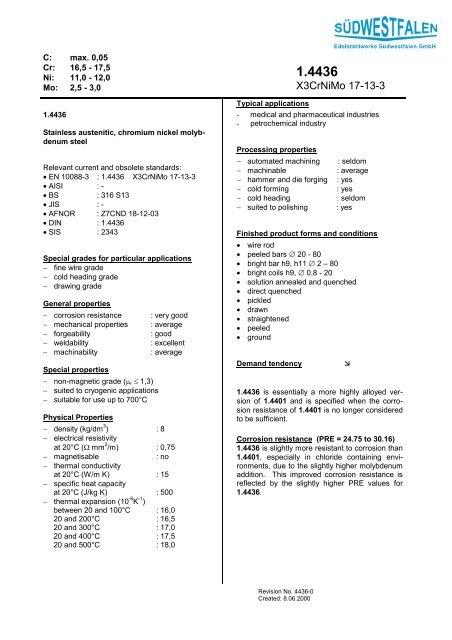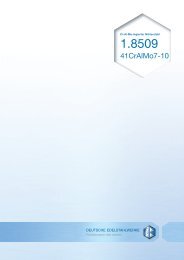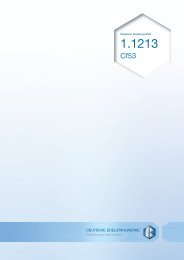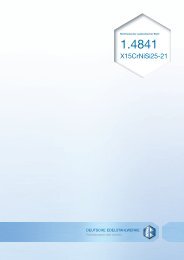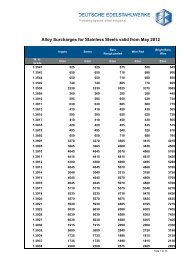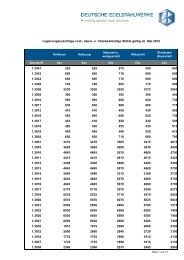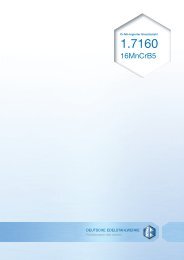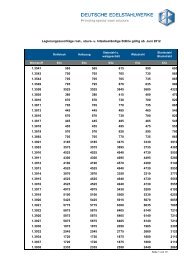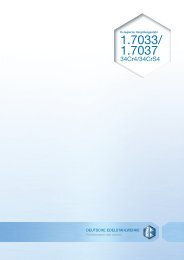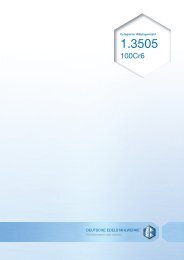1.4436 - DEW-STAHL.COM
1.4436 - DEW-STAHL.COM
1.4436 - DEW-STAHL.COM
Create successful ePaper yourself
Turn your PDF publications into a flip-book with our unique Google optimized e-Paper software.
C: max. 0,05<br />
Cr: 16,5 - 17,5<br />
Ni: 11,0 - 12,0<br />
Mo: 2,5 - 3,0<br />
<strong>1.4436</strong><br />
Stainless austenitic, chromium nickel molybdenum<br />
steel<br />
Relevant current and obsolete standards:<br />
� EN 10088-3 : <strong>1.4436</strong> X3CrNiMo 17-13-3<br />
� AISI : -<br />
� BS : 316 S13<br />
� JIS : -<br />
� AFNOR : Z7CND 18-12-03<br />
� DIN : <strong>1.4436</strong><br />
� SIS : 2343<br />
Special grades for particular applications<br />
�� fine wire grade<br />
�� cold heading grade<br />
�� drawing grade<br />
General properties<br />
�� corrosion resistance : very good<br />
�� mechanical properties : average<br />
�� forgeability : good<br />
�� weldability : excellent<br />
�� machinability : average<br />
Special properties<br />
�� non-magnetic grade (�r � 1,3)<br />
�� suited to cryogenic applications<br />
�� suitable for use up to 700°C<br />
Physical Properties<br />
�� density (kg/dm 3 ) : 8<br />
�� electrical resistivity<br />
at 20°C (� mm 2 /m) : 0,75<br />
�� magnetisable : no<br />
�� thermal conductivity<br />
at 20°C (W/m K) : 15<br />
�� specific heat capacity<br />
at 20°C (J/kg K) : 500<br />
�� thermal expansion (10 -6 K -1 )<br />
between 20 and 100°C : 16,0<br />
20 and 200°C : 16,5<br />
20 and 300°C : 17,0<br />
20 and 400°C : 17,5<br />
20 and 500°C : 18,0<br />
Typical applications<br />
<strong>1.4436</strong><br />
X3CrNiMo 17-13-3<br />
- medical and pharmaceutical industries<br />
- petrochemical industry<br />
Processing properties<br />
�� automated machining : seldom<br />
�� machinable : average<br />
�� hammer and die forging : yes<br />
�� cold forming : yes<br />
�� cold heading : seldom<br />
�� suited to polishing : yes<br />
Finished product forms and conditions<br />
�� wire rod<br />
�� peeled bars � 20 - 80<br />
�� bright bar h9, h11 � 2 – 80<br />
�� bright coils h9, � 0,8 - 20<br />
�� solution annealed and quenched<br />
�� direct quenched<br />
�� pickled<br />
�� drawn<br />
�� straightened<br />
�� peeled<br />
�� ground<br />
Demand tendency �<br />
<strong>1.4436</strong> is essentially a more highly alloyed version<br />
of 1.4401 and is specified when the corrosion<br />
resistance of 1.4401 is no longer considered<br />
to be sufficient.<br />
Corrosion resistance (PRE = 24.75 to 30.16)<br />
<strong>1.4436</strong> is slightly more resistant to corrosion than<br />
1.4401, especially in chloride containing environments,<br />
due to the slightly higher molybdenum<br />
addition. This improved corrosion resistance is<br />
reflected by the slightly higher PRE values for<br />
<strong>1.4436</strong>.<br />
Revision No. 4436-0<br />
Created: 8.06.2000
Properties, applications and processing<br />
<strong>1.4436</strong> displays excellent resistance to corrosion<br />
in most natural waters (urban, rural and industrial),<br />
even at moderate chloride and salt contents.<br />
In the food, beverage and agricultural sectors,<br />
<strong>1.4436</strong> displays excellent corrosion properties.<br />
This grade of stainless steel is also resistant<br />
to corrosion in various acid environments.<br />
Due to its relatively high carbon content, <strong>1.4436</strong><br />
is not considered to be resistant to intergranular<br />
corrosion in the welded condition. Despite this,<br />
thin sections may be welded without the danger<br />
of intergranular corrosion. Please note that<br />
<strong>1.4436</strong> is not resistant to sea water.<br />
Heat treatment / mechanical properties<br />
Optimal mechanical and fabrication properties<br />
are realised after solution annealing in the temperature<br />
range 1020 - 1120°C followed by rapid<br />
cooling in air or water.<br />
In the solution annealed condition, the following<br />
mechanical properties may be attained when<br />
testing in the longitudinal direction:<br />
Property Specification Typical<br />
- yield strength (N/mm 2 ) Rp0,2 : � 200 370<br />
- tensile strength (N/mm 2 ) Rm : 500 – 700 670<br />
- tensile elongation (%) A5 : � 40 46<br />
- hardness HB : � 215 200<br />
- impact energy (J) @ 25°C ISO-V : � 100 220<br />
Weldability<br />
<strong>1.4436</strong> is readily weldable using all welding processes.<br />
Should a filler material be required, Novonit<br />
� 4430, can be used. Maximum interpass<br />
temperature during welding is 150°C. Heat<br />
treatment after welding is not necessary, but it<br />
must be borne in mind that the relatively high<br />
carbon content, allowed for in the specification,<br />
can result in the formation of chromium carbides<br />
which in turn can result in susceptibility to intercrystalline<br />
corrosion. When <strong>1.4436</strong> is ordered<br />
from KEP, however, no such problems should<br />
arise, since the carbon content has been reduced<br />
to such low levels that this problem has been<br />
eliminated.<br />
Any scale or heat tint that results from welding or<br />
high temperature processing must either be mechanically<br />
or chemically removed followed by a<br />
suitable passivating treatment to restore the corrosion<br />
resistance.<br />
Elevated temperature properties<br />
The elevated temperature properties of <strong>1.4436</strong><br />
are essentially the same as for<br />
1.4401. The following minimum tensile properties<br />
at various temperatures are specified in the EN<br />
10088-3 : 1995 standard.<br />
Minimum proof stress (N/mm 2 )<br />
240<br />
220<br />
200<br />
180<br />
160<br />
140<br />
120<br />
100<br />
0<br />
Forging<br />
100<br />
1% proof stress<br />
0.2% proof stress<br />
200<br />
300<br />
Test temperature ( C)<br />
Work pieces are usually pre-heated to between<br />
1150 - 1200°C with forging taking place between<br />
1200 and 900°C. After forging, the forged component<br />
must be rapidly cooled in either air or<br />
water to avoid the formation of any undesirable<br />
phases which might adversely affect the corrosion<br />
and/or mechanical properties.<br />
Machining<br />
As a result of its higher alloy content, <strong>1.4436</strong> is<br />
more difficult to machine than 1.4401 or 1.4435<br />
(Nirocut � version). For applications which require<br />
machining, the use of NIRO-CUT � 4435 can be<br />
considered. When machining <strong>1.4436</strong>, the following<br />
cutting parameters can be used as a guideline<br />
when using coated hard metal cutting tools.<br />
tensile strengths depth of cut (mm)<br />
feed (mm/rev)<br />
Rm in N/mm 2 6 mm 3 mm 1 mm<br />
0,5 mm/r 0,4 mm/r 0,2 mm/r<br />
solution annealed<br />
(560 - 640) 115 m/min 145 m/min 185 m/min<br />
General comments<br />
Although <strong>1.4436</strong> might be slightly cheaper than<br />
1.4435, it finds itself in a diminishing market as<br />
far as profiles is concerned. A possible reason<br />
for this could be that most profiles are subjected<br />
to further processing by machining and to date no<br />
NIRO-CUT � version exists. Most customers thus<br />
specify the improved machining, <strong>1.4436</strong>, which<br />
despite its higher sulphur content displays an<br />
almost equivalent corrosion resistance.<br />
Revision No. 4436-0<br />
Created: 8.06.2000<br />
400<br />
500<br />
600


